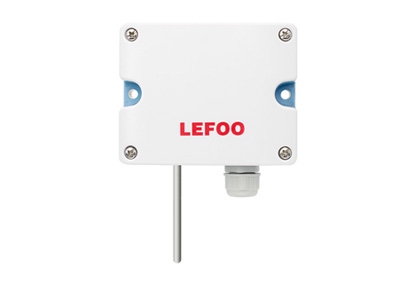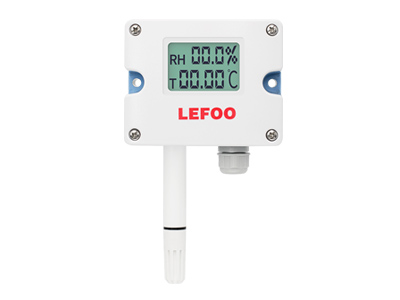Передатчик
 +
+
Датчик температуры Lefoo
Различные выходы и крепления
Примените датчик Heraeus A-класса
Уровень защиты:Защита от помех IP65;
КЭ & аттестованные РоХС
 +
+
Датчик температуры и влажности
Защита от помех:Время отклика 10S
Диапазон измерения:0% ~ 100% относительной влажности
Точность измерения:2% полной шкалы
Подсветка ЖК-дисплея:Температура + относительная влажность
 +
+
Внутренний датчик температуры и влажности
Защита от помех:Время отклика ≤ 10S
Диапазон измерения:0% ~ 100% относительной влажности (влажный)
/0 ~ 50 ℃, -20 ~ 60 ℃, етк. (Темп)
Дисплей:ЖК-дисплей Дополнительно
A temperature and humidity transmitter is a transmitter device that is equipped with humidity-sensitive and temperature-sensitive elements, which can be used to measure temperature and humidity and display them. Due to its small size, stable performance and high precision, the temperature and humidity transmitter can be widely used in computer rooms, HVAC, buildings, warehouses and other places where temperature and humidity measurement and control are required.
Temperature: A physical quantity that measures the cold and heat of an object, and is one of the seven basic physical quantities in the International System of Units. In production and scientific research, many physical phenomena and chemical processes are carried out at a certain temperature, and people's lives are closely related to him.
Humidity: Humidity has been closely related to life for a long time, but it is difficult to express in quantity.
The most commonly used physical quantity to express humidity in daily life is the relative humidity of the air. Expressed in %RH. There is a close relationship between relative humidity and temperature in the derivation of physical quantities. For a certain volume of airtight gas, the higher the temperature, the lower the relative humidity, and the lower the temperature, the higher the relative humidity. This involves complex thermal engineering knowledge.
Some definitions of humidity:
Relative Humidity: In the measurement method, humidity is defined as the "quantity of the state of the object". The humidity referred to in daily life is relative humidity, expressed in RH%. In short, it is the percentage of saturated water vapor (saturated water vapor pressure) in a gas (usually air) that contains the same amount of water vapor (water vapor pressure) as its air.
Absolute humidity: refers to the actual amount of water vapor contained in a unit volume of air, generally in grams. Temperature has a direct impact on absolute humidity. In general, the higher the temperature, the more water vapor is emitted, and the greater the absolute humidity; on the contrary, the lower the absolute humidity.
Saturated humidity: The maximum amount of water vapor that can be contained in the air per unit volume at a certain temperature. If this limit is exceeded, the excess water vapor will condense and become water droplets, and the air humidity at this time becomes saturated humidity. The saturated humidity of the air is not fixed, it varies with the temperature. The higher the temperature, the more water vapor can be contained in a unit volume of air, and the greater the saturated humidity.
Dew point: refers to the air containing a certain amount of water vapor (absolute humidity). When the temperature drops to a certain level, the water vapor contained will reach a saturated state (saturated humidity) and begin to liquefy into water. This phenomenon is called condensation. The temperature at which water vapor begins to liquefy into water is called the "dew point temperature" or "dew point" for short. If the temperature continues to drop below the dew point, the supersaturated water vapor in the air will condense into water droplets on surfaces. In addition, the wind is closely related to the temperature and humidity in the air, and it is also one of the important factors affecting the change of air temperature and humidity.
When choosing a temperature and humidity sensor, it is necessary to consider the range of its measurement. Now using temperature and humidity sensors, such as meteorology and scientific research departments, the general requirements for temperature and humidity detection and control do not need to be too high, that is, they do not need full humidity ---- 0 to 100% RH to measure.
It is very important to choose the measurement accuracy of the temperature and humidity sensor. As long as the measurement accuracy of the sensor is improved by one percentage point, it seems to be a step up for the temperature and humidity sensor. In order to be able to use the temperature and humidity sensor better, or to save the buyer's money, it is necessary to choose the required measurement accuracy of the temperature and humidity sensor. Therefore, those who need to buy a temperature and humidity sensor must carefully select the measurement accuracy of the temperature and humidity sensor.
It is necessary to consider the time drift and temperature drift in the actual application of the humidity sensor. When we use the humidity sensor, due to the influence of some dust, oil and some harmful gases, after a period of use, the electronic humidity sensor will age, which will lead to a decrease in the accuracy of the humidity sensor. Therefore, the general manufacturer will carefully mark the effective time of a calibration, which is about one to two years. After the expiration, it needs to be re-calibrated.
When choosing a temperature and humidity sensor, in addition to considering the above points, it is also necessary to note that it is best not to choose to use the temperature and humidity sensor in some acidic, alkaline or organic solvent-containing environments. Also, in order to accurately measure the humidity of the space, do not place the temperature and humidity sensor near the wall and where the air is not smooth. If you want to measure the temperature and humidity of a relatively large space, it is best to use several temperature and humidity sensors to measure together, which can improve the quality of the measured data.
22 Oct 2023
Шаг в будущее: эволюция перистальтических насосов с шаговым двигателем14 Oct 2023
Инновационная обработка жидкостей: путь перистальтического насоса шагового двигателя к точности06 Oct 2023
Точность и контроль жидкости: обнародовать мощность перистальтического насоса шагового двигателя24 Sep 2023
Использование инноваций: будущее очистки воды с помощью насосов для очистки водыЗапрос на продукт
 English
English  français
français  Deutsch
Deutsch  Español
Español  italiano
italiano  русский
русский  português
português  العربية
العربية  Türkçe
Türkçe  Zulu
Zulu 